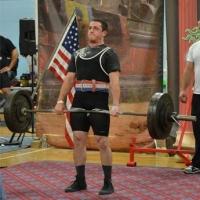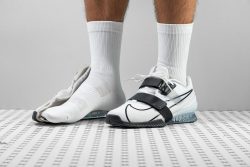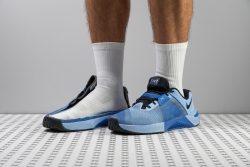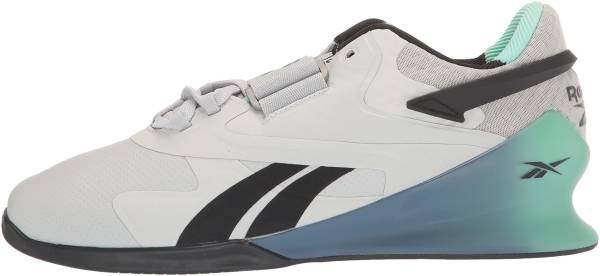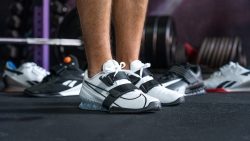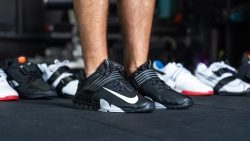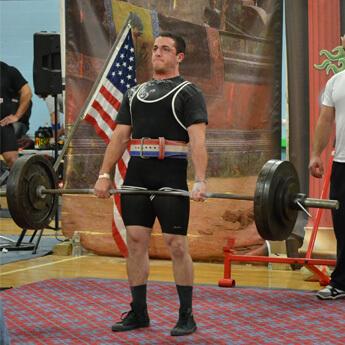3 Best Nike Weightlifting Shoes in 2025
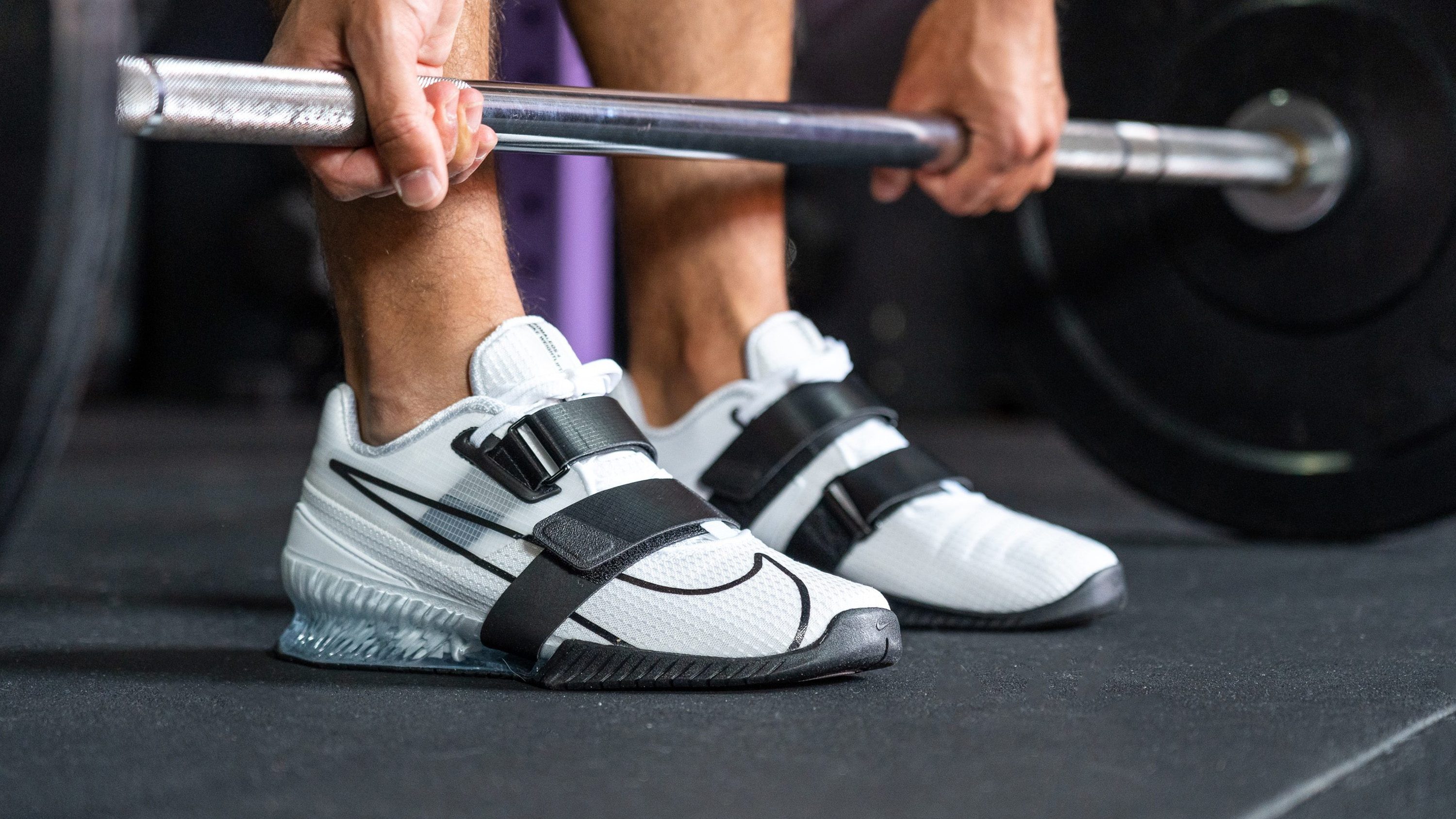
We buy shoes ourselves. We earn commissions when you buy through us, at no extra cost. Why trust us
When it comes to superb support and stability for a tough weightlifting workout, Nike is hands down one of the best and most trusted brands out there. From weightlifting-focused designs like the Nike Romaleos line to a more versatile Metcon series, the Swoosh label has you covered.
Whatever weightlifting regimen you’re into right now, you have to have proper weightlifting shoes that provide reliable traction to avoid slipping and a low, flat and wide heel for good stability. Nike is not just about good looks, their models offer better technologies to help you push harder.
After testing the Nike weightlifting shoes available, we present you here our top picks.
How we test Nike weightlifting shoes
Ranking all the shoes on this list requires serious wear tests and lab analysis. Yes, we bring the shoes to our independent shoe testing laboratory for micro-level examination of their essential parts. We check the technologies used and double-check their traction, durability, breathability, flexibility and other features.
Our data-driven approach includes the following:
- Buying all the Nike weightlifting shoes for our test sessions. We spend our own money on this to avoid any brand influence.
- We spend hours in the gym weightlifting in a particular pair of Nike shoes, subjecting them to the wear and tear of daily workouts. We note everything about the fit, comfort, and performance.
- Writing our reviews with 100% honesty based on our wear tests and lab data.
Best overall Nike weightlifting shoe
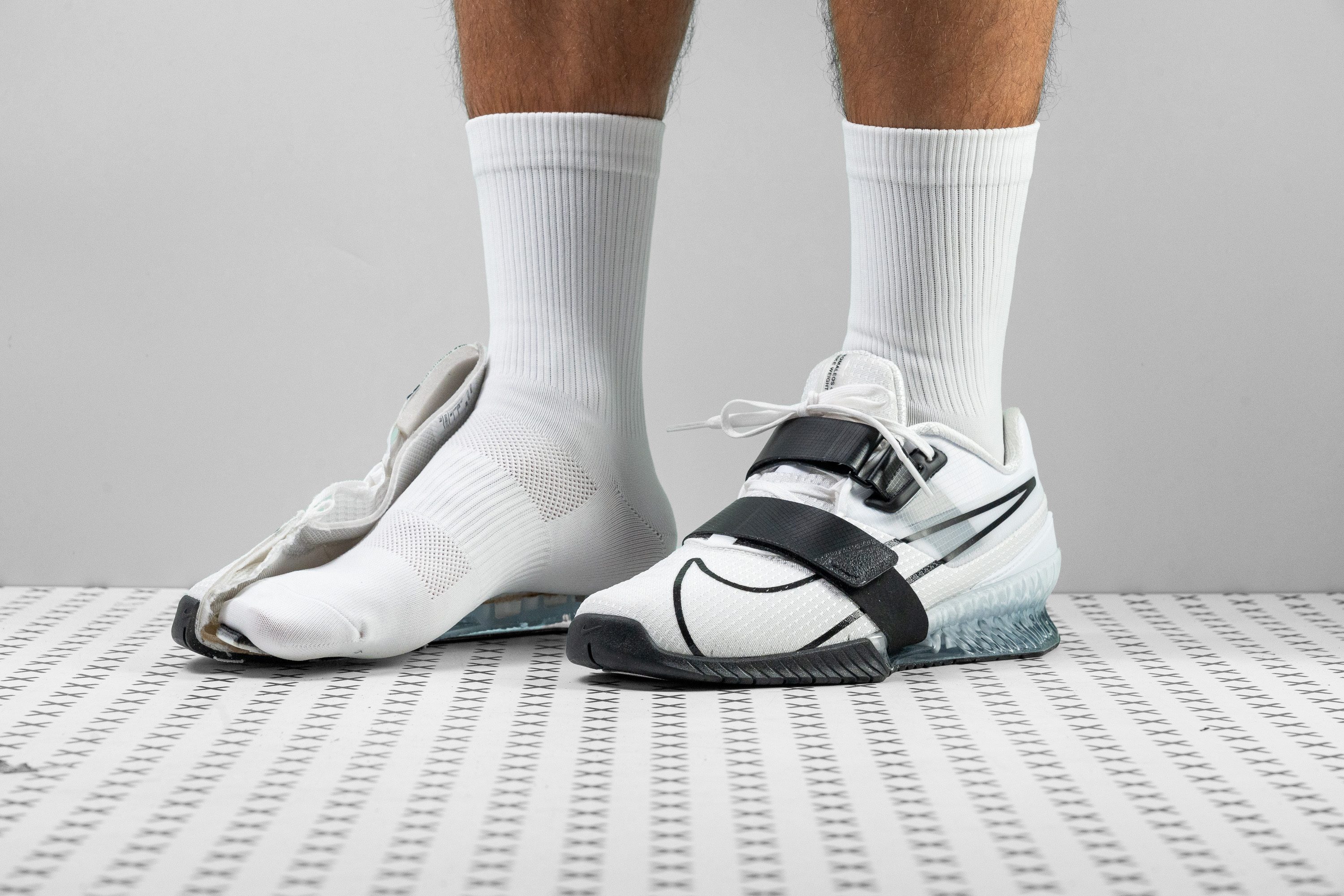





























What makes it the best?
Among Nike’s weightlifting trainers, it’s the Romaleos 4 that reigns supreme because of how it performed during our tests. Aside from having such a wide and stable base, this shoe also had a generously padded tongue that improved the fit and lockdown greatly. We were also impressed by how firm the midsole was, which effectively eliminated all forms of wobbliness.
Our caliper measurements in the lab revealed that the midsole is wider than average by 4.4 mm at the forefoot and 4.2 mm at the heel. The extra width served as the able cradle for our toe splays and even some in-shoe shifts of our feet, which happened a lot when we lifted heavier weights.
The two-strap design and the thick tongue worked together to keep our feet securely mounted on the footbed. Using a caliper, we learned that the tongue has 7.4 mm of padding (average is 5.6 mm).
The average midsole has a softness score of 75.0 on the HA durometer. The tooling for the Nike Romaleos 4 is way firmer than that at 97.0.
During our smoke test, we observed that not a lot of smoke was able to escape through the upper material. Hence, this shoe only got a 2 out of 5 for breathability. Going to non-air-conditioned gyms while wearing this shoe might be a sweaty disaster.
Pros
- Phenomenal stability
- Sturdy platform and sole
- Better lockdown with two straps
- Comfortable for a lifting shoe
- True to size
- Efficient traction
- Appealing looks
Cons
- Upper lacks durability
- Not for narrow ankles
- Not breathable
Best hybrid Nike weightlifting shoes
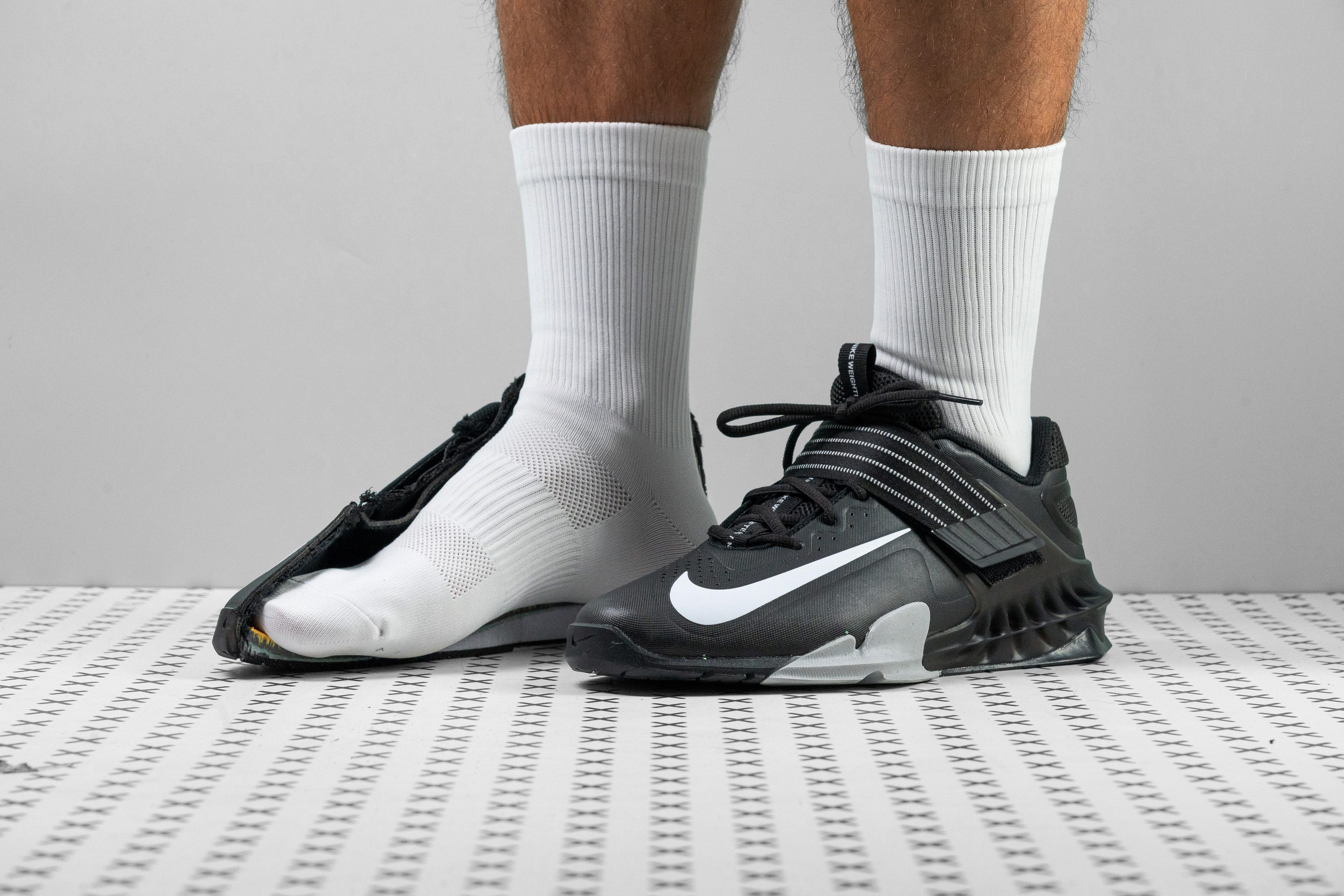







































What makes it the best?
The Nike Savaleos was just amazingly stable. It was practically impossible for it to twist or bend, making it such an amazing weightlifting shoe. But it was more than just a weightlifting trainer. It was lightweight and with a surprisingly soft midsole for a weightlifting shoe. Hence, we didn’t have qualms about using it for other types of workouts. Was this the best hybrid trainer in Nike’s weightlifting arsenal? Definitely it was!
After manual tests in the lab, we gave this shoe a perfect 5 for torsional rigidity. Its platform was amazingly wide, too. It was 116.0 mm (average was 107.7 mm) wide at forefoot while it was 94.2 mm (average was 86.7 mm) wide at the heel. Together, these features afforded us the most stable experience ever!
When we assessed its weight, the Nike Savaleos came in lighter than average (17.53 oz or 497g) at only 14.82 ounces or 420 grams. The weight reduction allowed us to do runs, walks, and jumps while wearing this shoe.
While the midsole of the average weightlifting shoe registered a staggering 69.2 on the HA durometer, the Savaleos came in at only 36.5! That’s an amazing 47% decrease in midsole hardness! Aside from stabilizing our stances, this shoe had the ability to absorb impact and keep pain away.
The Savaleos from Nike would have been a lot better if it were more accommodating of wider feet. But it wasn’t. Its toebox just felt too narrow even for us who had medium feet.
Pros
- Superb stability for moderate lifting
- Good for non-lifting exercises
- Very lightweight for a lifter
- Secure lockdown
- Flexible forefoot
- Excellent grip
- Comfortable in-shoe feel
- Reasonably priced
Cons
- Not for heavy weightlifting
- Not for wide feet
- Upper lacks durability
Best Nike cross-training shoes for weightlifting















































What makes it the best?
The Metcon 10 emerges as the ultimate cross-trainer among Nike weightlifting shoes, excelling in unwavering support for our demanding workouts. As proven by our lab, its sturdy base makes it a standout performer in lifting, while its fluid design and grip make it an excellent trainer for a range of activities.
We performed all types of lifts and felt steady despite the absence of a raised heel. Metcon 10 retains a low profile for higher ground sensitivity and enhanced control. Our lab reveals a below-average 22.8/16.2 mm stack, with a Hyperlift plastic insert in the heel ensuring it won’t bottom out as we lift heavier weights. Also keeping us locked in is the midfoot band and supportive upper.
Metcon 10 isn’t limited to lifting. Versatility shines through as it effortlessly handles box jumps, rope climbs, lunges, and more thanks to its high flexibility and traction. It instills a sense of confidence and security as we perform each workout, knowing we won’t lose control even on slippery floors.
Our traction test offers evidence with an impressive 0.38 friction coefficient. We felt that the midsole supported our free movements, measuring 13.2% more adaptive than average as per our bend test.
Despite its flexibility, the Metcon 10 isn’t the ideal pick for cardio-intensive routines or repetitive rope jumps due to its low impact protection.
Pros
- More versatile Metcon overall
- One of the lightest Metcons ever!
- ReactX adds shock absorption and energy return
- Increased forefoot flexibility
- Still amazingly stable for weightlifting
- Fantastic upper durability (even for rope climbs)
- Great grip on gym floors
- Highly secure foot lockdown
- Accommodating fit and toebox
- Handy Lace Tuck
Cons
- Outsole could be more durable
- Upper lacks breathability
Here is our guide to buying the ideal pair of Nike weightlifting shoes to meet your lifting needs. As a personal trainer and weightlifting devotee, I've been using and recommending Nike shoes for decades. Read on for a breakdown of the key things you need to understand and the main criteria to consider when shopping for a pair of Nike weightlifting shoes.
What to consider when choosing a Nike weightlifting shoe
Here are the key characteristics to consider when choosing a Nike lifting shoe:
| Heel height |
0.6 inches (15 mm): Nike Savaleos Best for beginners, lifting and other gym exercises |
|
0.8 inches (20 mm): Nike Romaleos Best for advanced lifters, weightlifting only |
|
| Fit |
Nike lifting shoes tend to fit snug and even tight. So, if you have wide feet, consider the Reebok Legacy Lifter instead. A weightlifting shoe should fit snugly, but not too tightly. You should be able to wiggle your toes, but the shoe should not move around on your foot during lifts. Try the shoes on with the socks you plan to wear for lifting to ensure a good fit. |
| Support |
Both Nike Romaleos and Savaleos have an excellent reputation in the support department. A weightlifting shoe should provide support for your feet and ankles during heavy lifts. Look for shoes with a sturdy, non-compressible sole, a stable heel, and a secure upper. |
Nike’s premier lifting shoe: The Romaleo
The Nike Romaleo was first introduced by Nike in 2008. The shoe was designed to meet the demands of Olympic weightlifters and was named after the legendary weightlifter, Tommy Kono.
The Romaleo was created to offer weightlifters the support and stability they need to perform their best, and it quickly became one of the most popular weightlifting shoes on the market.
The Romaleo was designed with a TPU heel clip for stability and support, a solid rubber outsole with a multi-directional traction pattern, Flywire technology for a secure fit, and a dual-density midsole for cushioning and support.
The synthetic leather and mesh upper provided durability and breathability, making the shoe a top choice for weightlifters.
Over the years, the Nike Romaleo has been updated and improved, with new versions being released to keep up with the latest trends and technologies in weightlifting shoes.
Romaleo version 2
Nike really made its mark on the weightlifting shoe scene with the introduction of the Romaleo 2 in January 2012. This dedicated lifting shoe was an immediate hit, with users loving the option of having both soft training insoles and hard competition insoles.
The Romaleo 2 was also 25% lighter than the original Romaleo, released four years previously.
The Romaleo 3 fails to impress
After five years of customer feedback, Nike brought out the Romaleo 3 in January 2017. There were quite a few differences between the two models - and many fans of the second iteration of Nike’s flagship weightlifting shoe were not impressed.

One of the biggest complaints about the Romaleo 3 was to do with the foot lockdown. Nike decided to do away with the dual straps of the previous version and replace it with a single metatarsal strap. Even though this strap was slightly wider than the straps used on the Romaleo 2 and did away with the overlap that some people complained about, it did not provide the same full foot security.
A second problem with the Nike Romaleo 3 has to do with its durability, or lack thereof. The shoe is considerably lighter than version 2. One of the main contributors to that lightness is a less dense tongue. It didn’t take long for users to begin to notice this difference; the tongue was prone to ripping, especially if you grab the shoe by its tongue (come on, we all do it!).
With version 3 of the Romaleo, Nike tried to create a hybrid shoe that would work both for serious weightlifting and general gym training. Just like Adidas with their Adipower 2, they discovered that that goal is impossible to achieve and you’ll only end up with a shoe that annoys weightlifting purists.
Romaleo version 4: back to basics
In 2020, Nike released the Romaleo 4. Responding to the negative feedback surrounding Version 3, the fourth iteration saw a return to the successful features of version 2. As a result, the Nike Romaleo 4 is a purer weightlifting shoe than version 3.
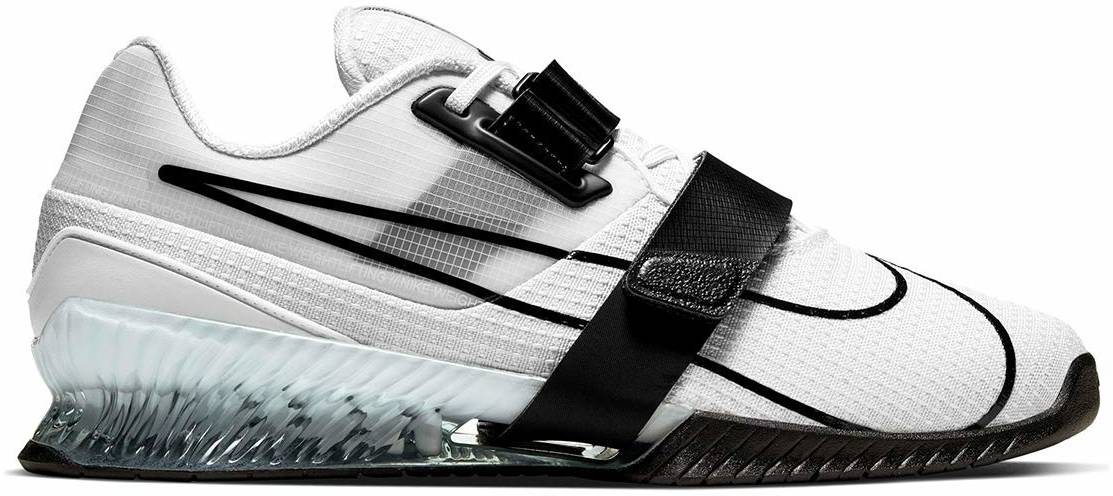
The Nike Romaleo 4 brings back the dual metatarsal straps of version 2. It also has a larger TPU midsole and is a bit heavier than the previous version. This increases stability and helps to keep you more grounded on the floor.
The upper of the Romaleo 4 has also replaced the thin leather of the previous version with a flexible woven fabric. It also has a wider, flatter outsole and heel and features a unique tread pattern for enhanced traction.
Romaleo 4 vs Savaleo
Just a year after the release of the Romaleo 4, Nike brought out the Savaleo. With this shoe, the company has attempted to meet the needs of Oly lifters as well as functional fitness trainers. To accomplish that goal the Savaleo has a wider toe box and enhanced grip around the toe area of the sole. There is also a padded mesh inset in the heel to absorb the impact when doing plyometric moves like box jumps.

The biggest difference between the Savaleo and any version of the Romaleo is the heel height. The average heel height of the four versions of the Romaleo was 0.75 inches. The Savaleo slashes that down to 0.5 inches. That reduction makes the shoe more versatile but also limits its effectiveness in keeping the body upright and promoting knee tracking when squatting.
As a result, the Savaleo is not considered a hardcore weightlifting shoe.
Romaleo vs Adidas Adipower vs Reebok Legacy Lifter
The Nike Romaleo, Adidas Adipower, and Reebok Legacy Lifter are all popular weightlifting shoes designed to help weightlifters perform their best. Aside from personal preferences, here are some of the reasons why many athletes chose (or didn't) one shoe over another:
|
Nike Romaleos
|
Adidas Adipower
|
Reebok Legacy Lifter
|
|
| Heel height | 0.8 inches (20 mm) | 0.8 inches (20 mm) | 0.9 inches (22 mm) |
|
+ better lockdown with two straps - tight |
+ more breathable - more expensive |
+ better for wide feet - heel slips |
Technologies used in Nike weightlifting shoes
Nike uses several proprietary technologies in its weightlifting shoes to provide weightlifters with the support, stability, and comfort they need to perform their best. Some of these technologies include:
| Flywire | Flywire technology is a series of strong, lightweight cables that are integrated into the upper of the shoe. The cables work together to provide a secure, snug fit that adapts to the movement of the foot. This helps to prevent slippage and keeps the foot firmly in place during heavy lifts. | 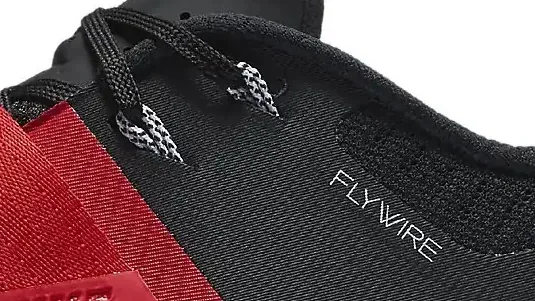 |
| TPU heel clip | The TPU heel clip is a hard, plastic heel counter that provides stability and support for the foot during heavy lifts. The clip helps to keep the heel in place and prevents it from sliding around in the shoe. |  |
| Solid rubber outsole | The solid rubber outsole provides traction and durability for the shoe. The outsole is designed to grip the floor and prevent slipping during lifts. | 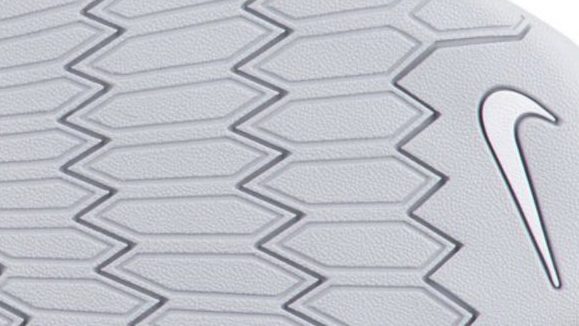 |
These proprietary technologies, combined with Nike's design expertise and attention to detail, make Nike weightlifting shoes some of the best on the market.
Up close with Nike FlyEase
Nike has forged a reputation as an innovator in the footwear industry. In February of 2021, that reputation was further enhanced with perhaps their most groundbreaking technology of all - FlyEase.
Even though the FlyEase hasn't (yet?) made its way into Nike's high-heeled lifting shoes, it's been introduced in the Nike Metcon 7 FlyEase, a top-rated cross-trainer that's often used for weightlifting.
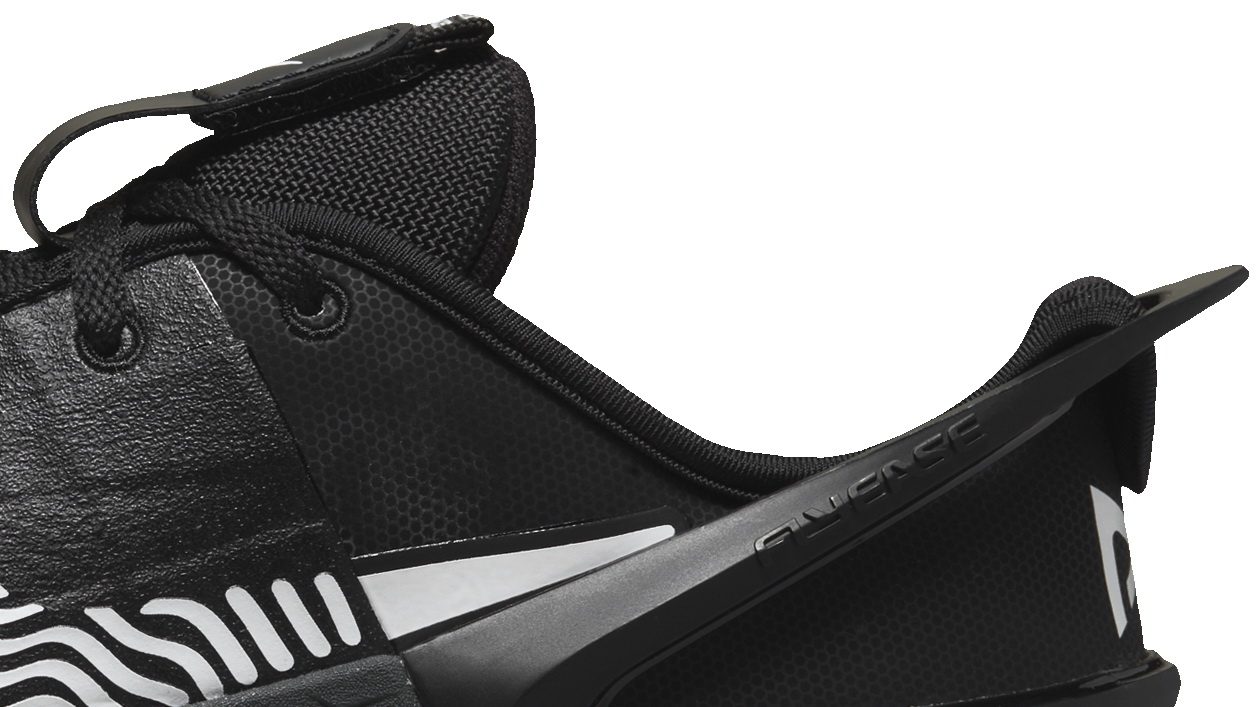
FlyEase is the first hands-free shoe sneaker technology. It incorporates a bi-stable hinge and midsole tensioner that allows wearers to use a kicking action to get in and out of the shoe. You kick down to put the shoe on and up to take it off.
FlyEase technology was originally designed for people with disabilities. It has become popular among the general population thanks to its ease of use, especially when your hands are full or you’re in a rush to get out the door.
At first, the idea of a shoe bending in the middle seems to run counter to everything we need from a weightlifting shoe - inflexibility, stability, and rigidity. But Nike believes they have addressed the durability issue with the inclusion of a tensioner band, which uses the same material used in the outsole. The Metcon 7 FlyEase includes a wide single metatarsal strap to provide a secure lockdown.
Frequently asked questions about Nike weightlifting shoes
Are Nike weightlifting shoes expensive?
Nike weightlifting shoes can range in price from around $100 to $200 or more, depending on the model and the features included. Compared to some other brands, Nike weightlifting shoes are in the mid-to-high range in terms of price.
It's important to keep in mind that the price of a weightlifting shoe is often a reflection of the quality of the materials and technology used. Higher-priced Nike weightlifting shoes typically have more advanced features, such as Flywire technology and a dual-density midsole, which can provide better stability, support, and comfort during lifts.
However, it's also possible to find good quality, budget-friendly weightlifting shoes from Nike that offer excellent value for the price. The key is to do your research and choose a shoe that fits your budget and meets your needs.
What is the best Nike weightlifting shoe for deadlifting?
When it comes to deadlifting, it's important to have a weightlifting shoe that provides stability, support, and grip. The best Nike weightlifting shoe for deadlifting would be one that meets these requirements and fits your individual needs.
A few of the top Nike weightlifting shoes for deadlifting include:
- Nike Romaleo: The Nike Romaleo is a popular weightlifting shoe that is designed for stability and support. The TPU heel clip and solid rubber outsole provide a stable platform for deadlifting, and the Flywire technology helps to keep the foot secure during heavy lifts.
- Nike Metcon 7: The Nike Metcon 6 is a versatile weightlifting shoe that is designed for a wide range of workouts, including deadlifting. The shoe features a flat, stable heel and a durable rubber outsole for excellent grip on the floor.
